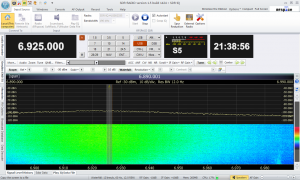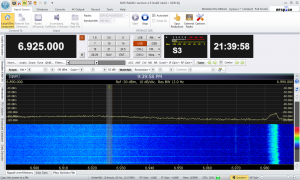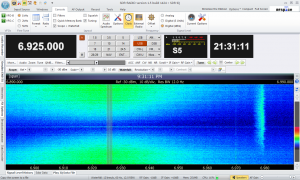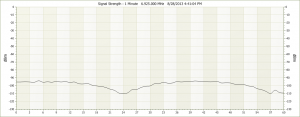After a rather moderate summer, Chicago has seen the appearance of a couple of spells of nasty heat and humidity. Along with this I have noted the appearance of a new noise in the 43 meter band and elsewhere. It is typically noted at around an S5 level with my resonant loop spun to the preferred azimuth. It begins in the late afternoon, chugs away at a rather high duty cycle for a couple of hours, and then settles in to a low duty cycle operation (a few minutes every hour) by 0100z. It has every indication that it is mains-related, and did not correlate with anything in my house. In the past I have had problems with leaky or grunged insulators on utility power poles, and the noise resulting from that has always exhibited a more random and intermittent nature; it has also tended to exhibit strengths in the range of S9 to S9+5. This new noise was kinder and gentler, but would still interfere with my ability to note weak carriers in the SDR waterfall. When I come down to the shack after work, I like to see an S2 noise floor in the late afternoon, when storm noise is not audible, with my preferred SDR gain settings ( IF = +18dB, RF = -10dB ). This was not the case.
I have just recently installed a rotor on the loop, a HyGain AR-303 light duty rotator which can easily handle a loop of this size. The goal then was to see what could be done about dealing with and possibly identifying the source of) this noise.
A small loop exhibits a “Figure 8″ reception pattern; there are two lobes of maximum reception which are aligned with the plane of the loop. There are 2 reception “nulls” which are at right angles to the plane of the loop. In theory, these nulls could be pointed at an offending noise source to minimize its impact on reception. The “Standard Loop” described in the HFU post here http://www.hfunderground.com/board/index.php/topic,12084.0.html has been designed to offer a good balance of reception properties. While I have slanted the design towards sensitivity, there is still enough ability to depress local noise sources. Let’s see how much.
Maximizing the noise by loop rotation, this is what was seen on the SDR waterfall:
The brightening of the waterfall palette is clearly seen across the resonant bandwidth of the loop, and it is easy to see that weak carriers or signals about 6925 (or at any frequency in the SDR display range) would be obscured. The SDR is reporting an average signal strength of S5 at 6925. To be honest, this would not be an issue if everyone was heard at S9+10; there might be some background buzzing in the audio. But for DX, I could not live with this.
The loop was then rotated so that the noise was minimized, and another screen cap was taken. The waterfall now appeared like this:
The noise about 6925 has been reduced significantly, and the SDR is now reporting a signal strength of S3 at 6925. This is a bit higher than what I would like, but I can live with that. Using a light touch on the SDR noise blanker helps to clean up most of the remaining audio buzz without introducing distortion.
Note also that a couple of things which were not visible in the previous image are now visible. The spur which we commonly see on 6970 is now there, as is a big blob of noise just above 6980. I do not know what this is, but I see it all the time. It generally hangs out around 6980 plus multiples of about 105 kHz above and below 6980. It generally stays close to this frequency, but it may move up or down and appear as massive interference at 6925. But it can be suppressed also. If you compare the previous image (max noise) and with this it can be seen that these two noise sources are at about 90 degrees apart in azimuth.
A better way to look at this would be by looking at the SDR waterfall as the loop is scanned. In a separate session (the following day) I again looked at these two noise sources by scanning the loop through approximately 180 degrees (from rotor north to rotor south) and taking took a screen cap of the entire scan. That is here:
This image clearly shows that around the time the rotor was pointing due east (lobes of max reception pointing east and west, nulls pointing north and south), the noise was minimized, It also shows that the rough azimuth of the second noise source around 6980 could be determined from the rotor position. The lobes of the null are not sharp, and there is a spread of a few degrees where the noise is minimized as a consequence of the loop null pattern. The loop is dealing with the noise fairly effectively. It seems to indicate that a noise reduction of about 2 S Units (12dB) is being observed.
A more accurate way to measure the noise reduction was tried. I use SDR Console to support the SDR-IQ, and the most valuable tool this software has is a Strength History window. I set the Strength History range to 60 seconds, and again scanned the loop from rotor north to south, while the history window recorded the loop output in dBm. Here is what I saw:
I currently have no way to calibrate the scan; I don’t know exactly when the scan started or stopped in the strength chart, but a rough guess would be that it started around 40 seconds into the chart, and ended around 10 seconds. No matter; the pattern minima and maxima are easy to see, and these are approximately -110 and -94dBm, a difference of 16dBm (approximately 2.6 S Units).
This is a typical value of the suppression which can be obtained against a local noise source. I have seen suppression against particular noise sources of up to 24dB (4 S Units), but this seems to be about the limit. I no longer freak when noise pops up; loop rotation can generally solve most of the problem, and judicious use of the software noise blanker generally cleans up the rest. As long as there is a reasonably wide azimuthal difference between the noise source and the desired station, effective noise reduction can be accomplished.
This was all done using an unshielded resonant loop; at some point in the future I would also like to try this with a Wellbrook loop.
It’s been a long boat ride here, but the noise source was pretty easy to ID by sighting through the loop. When the noise was suppressed, the null pointed directly at my neighbor’s air conditioning unit, and it looks to me like it’s time for him to call his service guy. I would be absolutely willing to do a quick and cheap fix for him with my Sawzall…





Have you tried to set up a recording over the course of 24+ hours for sampling every minute or so, with the loop at maximum and minimum noise?
I have similar problems, but with several different types of noise.
One source is from my UPSes, which is entirely my responsibility to fix.
The rest come through the mains. Tracked down one of them and it seems to be maximum over an area on the side of my house. I have underground power, so would assume there’s a vault under there with probably a transformer.
Another type of noise comes on like clockwork on the weekends for a couple of hours wreaking havoc on MW. Again, through the power lines. Its sounds like a slow data transmission, but unsure for what.
My previous neighbors had something that would generate a ton of noise. Never found out what and they moved out. New neighbors in and haven’t really noticed a difference, so could be a stupid dimmer. Or any number of other stupid “modern” electronic doodads.
Did a lot of DF with a portable radio on MW/LW. Also have a Wellbrook ALA-1530S+ on a rotor hooked up to a Perseus. As I rotate that thing, can certainly diminish some of the noise, but have noise coming from various locations. Luckily, all is not lost yet, as the loop is in the garage and I can stick it out in the shed in the back of the yard. Problem is burying the cable & running it back (i.e. actually doing the work. I’ve been saying this all summer and its quickly running out. Winter will soon be here and once the ground is frozen, that’s it until spring).
“Have you tried to set up a recording over the course of 24+ hours for sampling every minute or so, with the loop at maximum and minimum noise?”
No, I don’t really have that capability…yet. I am currently putting in a control system to handle the operation of loops, other antennas, rotors, an SDR, etc under software control. Progress is slow and steady, and maybe that will be ready for testing by next spring. Until then it’s just old school DXing here.
I did have to bite the bullet and trench in cables this summer for this project, a 150 foot underground run. I put in a pair of 7 wire sprinkler control cables (one for rotor control, one for bringing power to the site), a pair of F75 direct burial coaxes, and a burial rated Cat 5 cable. If you’re trenching, it probably pays to put a 2nd coax for your loop; just never know when one is going to go bad.
The trenched in cables are quieter, not because of any earth shielding (they are buried 6″ deep) but because the routing for the old cables was pretty bad (along a chain link fence, next to low voltage lighting cable, right past my power service entry).
Power line noise is just bad news; I was lucky in that I was able to get them – Com Ed – to come out and fix my pole without dropping an F-bomb on their customer service. I stretched the truth a bit and said that the noise was interfering with my internet service (ATT) and cable provider (Comcast). They came out pretty quickly. Some utilities have an RFI guy on staff; maybe your utility would be willing to come out on a consult?
My neighbor has an underground line to her garage, with an above-ground transformer. These are not all that noisy, but I can’t site a loop near them; I keep my loop about 120′ from them.
I wish you all the luck! It is getting harder and harder to site antennas on the common residential lot, giving the sum total of crap our appliances generate. The Wellbrook should be a big help; it’s good but far from perfect.